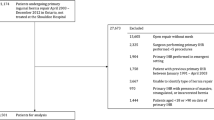Abstract
Background
Few studies have comprehensively and systematically analyzed nationwide samples. This study purposed to explore temporal trends and predictors of medical resource utilization and medical outcomes in these patients to obtain data that can be used to improve healthcare policies and to support clinical and administrative decision-making.
Methods
This study used nationwide population data contained in the Longitudinal Health Insurance Database of Taiwan. The 14,970 inguinal hernia repair patients were enrolled in this study (age range, 18–100 years) from 1997 to 2013 in Taiwan. After temporal trends analysis of demographic characteristics, clinical characteristics, and institutional characteristics, predictors of postoperative medical resource utilization and medical outcomes were evaluated through multiple linear regression analysis and Cox regression analysis.
Results
The prevalence of inguinal hernia repair per 100,000 population significantly decreased from 195.38 in 1997 to 39.66 in 2013 (p < 0.05). Demographic characteristics, clinical characteristics, and institutional characteristics were significantly associated with postoperative medical resource utilization and medical outcomes (p < 0.05). Of these characteristics, both surgeon volume and hospital volume had the strongest association.
Conclusions
The inguinal hernia repair prevalence rate gradually decreased during the study period. Demographic characteristics, clinical characteristics, and institutional characteristics had strong associations with postoperative medical resource utilization and medical outcomes. Furthermore, hospital volume and surgeon volume had the strongest associations with postoperative medical resource utilization and medical outcomes. Additionally, providing the education needed to make the most advantageous medical decisions would be a great service not only to patients and their families, but also to the general population.

Similar content being viewed by others
References
Nitin K, Puneeth T (2017) Comparative study between Hernioplasty and Herniorrhaphy at Basasveshwara teaching and general hospital. Kalaburagi Sch J App Med Sci 5:2740–2744
Armijo PR, Pokala B, Misfeldt M et al (2019) Predictors of Hiatal Hernia recurrence after laparoscopic anti-reflux surgery with Hiatal Hernia repair: a prospective database analysis. J Gastrointest Surg 23:696–701
Lindmark M, Strigård K, Löwenmark T et al (2018) Risk factors for surgical complications in ventral hernia repair. World J Surg 42:3528–3536. https://doi.org/10.1007/s00268-018-4642-6
Chen HR, Ting HK, Kao CC et al (2018) Robot-assisted radical prostatectomy may induce inguinal hernia within the first 2 years: an 11 year single-surgeon experience of > 400 cases. Medicine. https://doi.org/10.1097/MD.0000000000012208
Parker SG, Halligan S, Blackburn S et al (2019) What exactly is meant by “loss of domain” for ventral hernia? Systematic review of definitions. World J Surg 43:396–404. https://doi.org/10.1007/s00268-018-4783-7
Aday AL, Awe WC (1997) Health services utilization models. In: Gochman DS (ed) Handbook of health behavior research I: personal and social determinants. Plenum Press, New York
Andersen R (2008) National health surveys and the behavioral model of health services use. Med Care 46:647–653
Kleinbaum DG, Kupper LL, Muller KE (eds) (1988) Applied regression analysis and other multivariable methods. PWS-KENT Publishing Co., Boston, Mass
Vu JV, Gunaseelan V, Dimick JB et al (2019) Mechanisms of age and race differences in receiving minimally invasive inguinal hernia repair. Surg Endosc 33:4032–4037
Keller JJ, Muo CH, Lan YC et al (2015) A nation-wide population-based study of inguinal hernia repair incidence and age-stratified recurrence in an Asian population. Hernia 19:735–740
Twu CM, Ou YC, Yang CR et al (2005) Predicting risk factors for inguinal hernia after radical retropubic prostatectomy. Urology 66:814–818
The HerniaSurge Group (2018) International guidelines for groin hernia management. Hernia 22:1–165
Zendejas B, Ramirez T, Jones T et al (2013) Incidence of inguinal hernia repairs in Olmsted County, MN: a population-based study. Ann Surg 257:520–526
Köckerling F (2018) What is the influence of simulation-based training courses, the learning curve, supervision, and surgeon volume on the outcome in hernia repair?-A systematic review. Front Surg 5:57
Köckerling F (2017) Data and outcome of inguinal hernia repair in hernia registers—a review of the literature. Innov Surg Sci 2:69–79
Becher RD, DeWane MP, Sukumar N et al (2020) Hospital volume and operative mortality for general surgery operations performed emergently in adults. Ann Surg 272:288–303
Köckerling F (2018) What is the influence of simulation-based training courses, the learning curve, supervision, and surgeon volume on the outcome in hernia repair?—A systematic review. Front Surg 5:57
Cornelissen D, Mwapasa G, Gajewski J et al (2018) The cost of providing district-level surgery in Malawi. World J Surg 42:46–53. https://doi.org/10.1007/s00268-017-4166-5
Olavarria OA, Bernardi K, Shah SK et al (2020) Robotic versus laparoscopic ventral hernia repair: multicenter, blinded randomized controlled trial. BMJ 370:m2457
Liem MSL, van Duyn EB, van der Graaf Y et al (2003) Recurrences after conventional anterior and laparoscopic inguinal Hernia repair: a randomized comparison. Ann Surg 237:136–141
Mitura K, Dąbrowiecki S, Śmietański M et al (2017) The experience and awareness of laparoendoscopic procedures among Polish surgeons in everyday clinical practice. Wideochir Inne Tech Maloinwazyjne 12:13–18
Memon MA, Fitzgibbons RJ (1998) Assessing risks, costs, and benefits of laparoscopic hernia repair. Annu Rev Med 49:95–109
Young MC, Saddoughi SA, Aho JM et al (2019) Comparison of Laparoscopic versus open surgical management of Morgagni Hernia. Ann Thorac Surg 107:257–261
Acknowledgements
This study was supported by funding from the NSYSU-KMU JOINT RESEARCH PROJECT (NSYSUKMU 109-P001) in Taiwan.
Author information
Authors and Affiliations
Corresponding author
Ethics declarations
Conflict of interest
The authors declare that they have no conflict of interest.
Ethical approval
The study protocol was approved by the Institutional Review Board of Kaohsiung Medical University Hospital (KMUH-IRB-2019067).
Additional information
Publisher's Note
Springer Nature remains neutral with regard to jurisdictional claims in published maps and institutional affiliations.
Rights and permissions
About this article
Cite this article
Kuo, YH., Chiu, CC., Tseng, LY. et al. Long-Term Trends and Predictors of Medical Resource Utilization and Medical Outcomes in Inguinal Hernia Repair: A Nationwide Cohort Study. World J Surg 45, 1771–1778 (2021). https://doi.org/10.1007/s00268-021-06012-8
Accepted:
Published:
Issue Date:
DOI: https://doi.org/10.1007/s00268-021-06012-8




